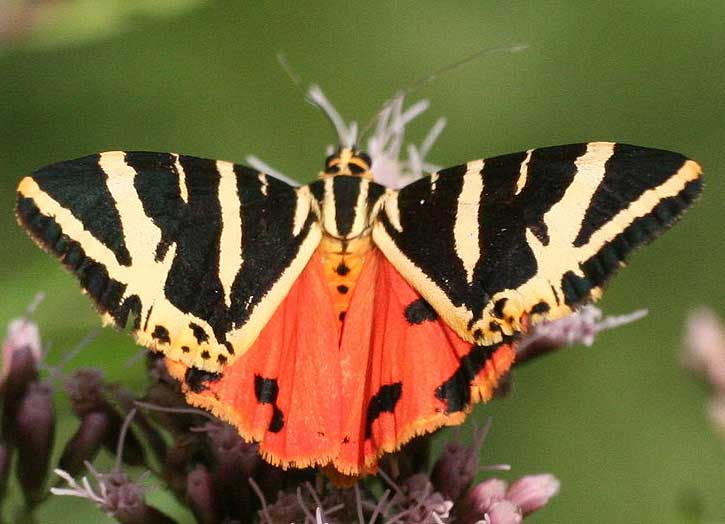
Euplagia quadripunctaria (*)
Superregnum: Eukaryota
Cladus: Unikonta
Cladus: Opisthokonta
Cladus: Holozoa
Regnum: Animalia
Subregnum: Eumetazoa
Cladus: Bilateria
Cladus: Nephrozoa
Cladus: Protostomia
Cladus: Ecdysozoa
Cladus: Panarthropoda
Phylum: Arthropoda
Subphylum: Hexapoda
Classis: Insecta
Cladus: Dicondylia
Subclassis: Pterygota
Cladus: Metapterygota
Infraclassis: Neoptera
Cladus: Eumetabola
Cladus: Endopterygota
Superordo: Panorpida
Cladus: Amphiesmenoptera
Ordo: Lepidoptera
Subordo: Glossata
Cladus: Coelolepida
Cladus: Myoglossata
Cladus: Neolepidoptera
Infraordo: Heteroneura
Cladus: Eulepidoptera
Cladus: Ditrysia
Cladus: Apoditrysia
Cladus: Obtectomera
Cladus: Macroheterocera
Superfamilia: Noctuoidea
Familia: Erebidae
Subfamilia: Arctiinae
Tribus: Arctiini
Subtribus: Callimorphina
Genus: Euplagia
Species: Euplagia quadripunctaria
Subspecies: E. q. fulgida – E. q. quadripunctaria – E. q. rhodosensis
Name
Euplagia quadripunctaria (Poda, 1761)
Synonyms
Phalaena (Noctua) quadripunctaria Poda, 1761
Callimorpha quadripunctaria (Poda, 1761)
Phalæna plantaginis Scopoli, 1763
Phalæna Noctua hera Linnaeus, 1767
Callimorpha hera (Linnaeus, 1767)
Euplagia hera (Linnaeus, 1767)
Callimorpha quadripunctaria magna Spuler, 1906
References
Daniel, F. 1953: Neue Heterocera-Arten und -Formen. Mitteilungen der Münchner Entomologischen Gesellschaft 43: 252–261. Full article. Reference page.
Linnaeus (Linné), C., 1767: [Lepidoptera]: 744–900. In: Linné, C., Systema Naturae, etc. Ed. 12. 1 (2): 533–1327, Holmiae.
Poda, N., 1761: Insecta Musei graecensis, quae in ordines, genera et species juxta Systema Naturae Caroli Linnaei digessit Nicolaus Poda, e Societate Jesu, Philosophiae Doctor et Matheseos Professor: 18+127 p., 2 tab., Widmanstadii, Graecii.
Scopoli, I.A., 1763: Entomologica Carniolica exhibens insecta carnioliae indigena et distributa in ordines, genera, species, varietates. Methodo Linnaeana: [36]+423 pp., 1 pl., Vindobonae.
Spuler, A., 1906: Fam. Arctiidae Stph. In: Spuler, A. Die Schmetterlinge Europas 2: 128–152, Stuttgart.
Witt, T.J. & Ronkay, L. (Eds.) 2011. Noctuidae Europaeae. Volume 13. Lymantriinae and Arctiinae, including phylogeny and check list of the quadrifid Noctuoidea of Europe. Entomological Press, Sorø, 448 pp. ISBN 978-87-89430-18-8. Reference page.
Vernacular names
français: Écaille chinée
magyar: Csíkos medvelepke
svenska: Sebraglansspinnare
Euplagia quadripunctaria, the Jersey tiger, is a day-flying moth of the family Erebidae. The species was first described by Nikolaus Poda von Neuhaus in 1761. The adult wingspan is 52–65 millimetres (2.0–2.6 in), and they fly from July to September, depending on the location.[1] They tend to fly close to Eupatorium cannabinum, where they are hard to notice because of their camouflage.
The larvae (caterpillars) are polyphagous, feeding from September to May on nettles (Urtica) and raspberries (Rubus),[2] dandelion (Taraxacum), white deadnettle (Lamium), ground ivy (Glechoma), groundsel (Senecio), plantain (Plantago), borage (Borago), lettuce (Lactuca),[3] and hemp-agrimony (Eupratoria).[1] The insect overwinters as a small larva.[1]
Large groups of adults of subspecies E. q. rhodosensis can be found on occasion aestivating (sheltering from the summer heat) in Petaloudes, on Rhodes, in a place that has become known as the Valley of the Butterflies.[4]
Distribution
Euplagia quadripunctaria is widely distributed in Europe from Estonia and Latvia in the north to the Mediterranean coast and islands in the south.[3] It is also found in western Russia, the southern Urals, Asia Minor, Rhodes and nearby islands, the Near East, Caucasus, southern Turkmenistan, and Iran.[5] Individuals are known to migrate northwards from their regular breeding grounds during the summer.[1]
British Isles
Aside from being frequent in the Channel Islands (whence its common name comes), this species was rarely seen in the British Isles in Victorian times.[3] It was described by William Forsell Kirby as, "a great rarity in the South of England, except one locality in Devonshire."[2] Since then however it has spread more widely in Devon and Cornwall,[1] and has recently been seen more frequently in southern England, especially on the Isle of Wight, in northern Kent,[6] and south London.[7] They have been seen regularly and in numbers every year in London first discovered at Devonshire Road Nature Reserve in Forest Hill since 2004, so it is probable that they have established a breeding colony.[8]
Mothrecording.org shows a string of connected sightings on the South Kent coast from Dover to Rye in the first two decades of the twenty-first century. These are disconnected from the block of sightings in South-West England and so probably came from the Continent directly.
Subspecies
Euplagia quadripunctaria quadripunctaria (Europe, Caucasus, Transcaucasus, northern Anatolia, northern Iran, southern Turkmenistan)
Euplagia quadripunctaria fulgida (South Turkey, Syria, Lebanon)
Euplagia quadripunctaria rhodosensis (Western Turkey and neighboring islands of Greece)
Conservation
This is the only lepidopteran which has been designated as a 'priority species' under Annex II of the Habitats Directive in the European Union, as of 1992,[9] which means areas in which it occurs can be declared Special Areas of Conservation.
References
Skinner, Bernard. (1984). The Colour Identification Guide to Moths of the British Isles (Macrolepidoptera). Viking (Penguin Books), London: ISBN 0-670-80354-5
Kirby, W. F. (1903). The Butterflies and Moths of Europe. Cassell & Co. Ltd., London: 432 pp.
South, R. (1920). The Moths of the British Isles. (Series 1, Second edition), Frederick Warne & Co. Ltd., London: 359 pp.
Heath, J. & Maitland, Emmet A. (1985). The Moths and Butterflies of Great Britain and Ireland. Vol.2, Harley Books Ltd., Colchester: ISBN 0-946589-02-X
Dubatolov, V. V. (2010). "Tiger-moths of Eurasia (Lepidoptera, Arctiidae) (Nyctemerini by Rob de Vos & Vladimir V. Dubatolov)". Neue Entomologische Nachrichten. 65: 1-106
Ferguson, I. D. (2009). Kent Moth Report 2005. Butterfly Conservation, Kent Branch: 56 pp. Archived 2014-08-21 at the Wayback Machine
"Sightings of Jersey tiger in Orpington, August 2012". RSPB.org also in Streatham, London, in July 2014.
Jersey tigers on UK Safari page
"Council Directive 92/43/EEC of 21 May 1992 on the conservation of natural habitats and of wild fauna and flora". Eur-Lex. Retrieved 22 September 2020.
Further reading
Roesler, U. (1968). "Panaxia quadripunctaria ssp. ingridae ssp. nov. (Lepidoptera, Arctiidae)". Entomologische Zeitschrift. 78 (24): 280-284, Stuttgart.
Retrieved from "http://en.wikipedia.org/"
All text is available under the terms of the GNU Free Documentation License

